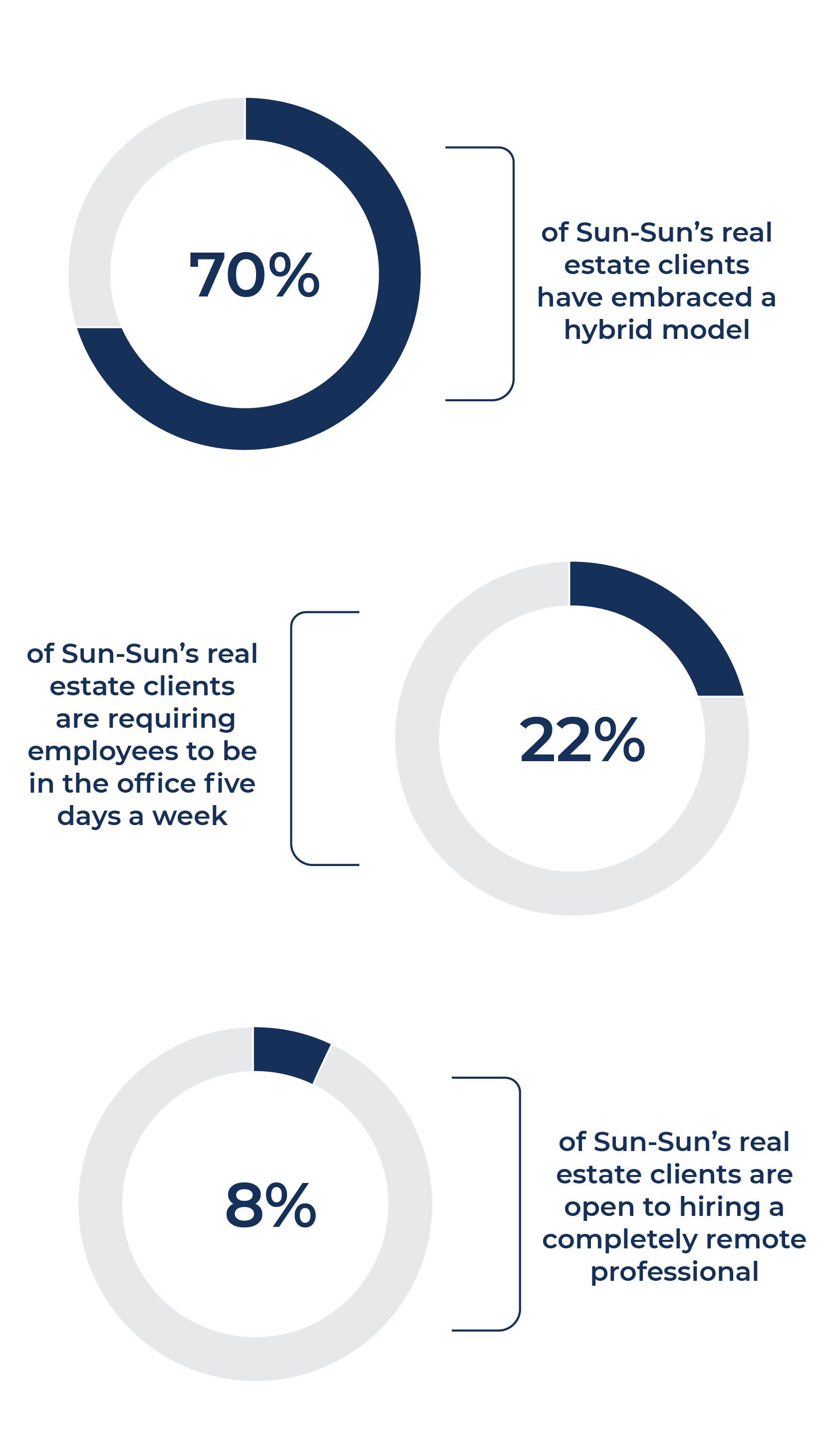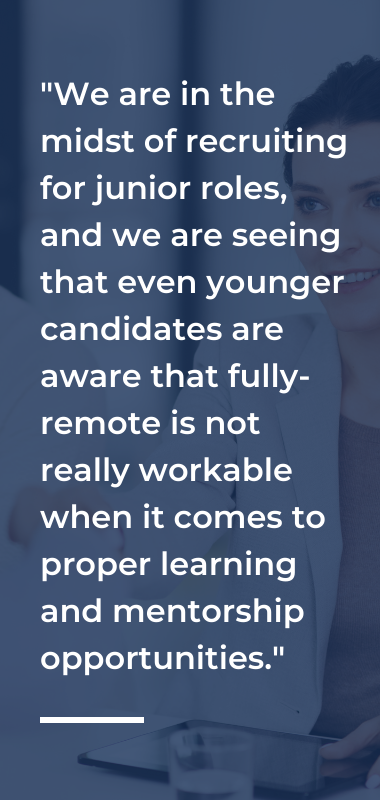When real estate capital advisor Ashley Anderson was searching for a role in the sector, a prospective company’s work–from–home policy quickly became paramount in her job search. “While most companies I looked at had some type of remote work policy, a lack thereof – especially coming out of the pandemic – was a red flag,” she said. “If the company didn’t see the benefit of providing this to their employees, in what other ways were they holding on to outdated policies? To me, offering remote work is a sign of a forward–looking organization.”
To me, offering remote work is a sign of a forward-looking organization.
– Ashley Anderson
Ashley ended up accepting a position with Hodes Weill & Associates, in part because they offered an attractive flexible work policy. Employees work together in the office on Monday, Tuesday, and Wednesday, and have the option to finish the week remotely.
Ever since the pandemic sent us all home in March of 2020, there have been discussions and debates about what work should and would look like when we were finally able to return to the office. Two years later, we are getting some real clarity about how the temporary quarantine has permanently changed the way we work.
REMOTE WORK POLICY
Ashley is not alone. At McDermott + Bull, we are seeing how an organization’s remote work policy is factoring heavily into our candidates’ decision–making process. Long before the pandemic, office workers were already asking for greater work–life harmony. It took a pandemic for most companies to start listening.
Whether they returned in 2020 or 2021, most organizations are now back to using their corporate spaces. Since returning to the office, 70% of my real estate clients have embraced a hybrid model, while just 22% are requiring employees to be in the office five days a week. Interestingly, only 8% are open to hiring a completely remote professional. Hybrid work spans the range from one day to four days in the office. Some firms dictate which days they want teams to be in-person, while others allow employees to choose which days they are in the office.
The companies that are listening to employees are seeing various benefits. In evaluating McDermott + Bull’s internal data for the real estate sector, it took an average of 91 days (or three months) to fill a position with a hybrid or fully remote schedule compared to 179 days (or six months) to fill a full-time in-office position. That’s nearly double!


In fact, some office–first jobs sat on the market much longer than six months. We saw many candidates voluntarily withdraw from consideration once they learned the role required a full five days of working in the office, forcing companies to re–evaluate their hiring priorities. A few firms relaxed their search criteria to include hybrid work or consider candidates based near one of their other office locations.
The hybrid model seems to be popular across all levels of experience. In my work, I’ve seen both mid–level candidates — many who have younger families — as well as senior–level candidates gravitate towards the hybrid model. It makes sense given that both levels have the expertise and networks necessary to be successful in their roles outside the office, plus they have the confidence and knowledge of who to reach out to for help within their company.
Early-career candidates don’t have this luxury. They are often still learning the ins and outs of their organizations, and many younger workers have said they truly value the camaraderie and mentorship that comes with working in an office environment. So, a hybrid schedule might also work best for these candidates, giving the younger generation who grew up with technology the freedom to work remotely while allowing them to tap into the benefits that come with being alongside their colleagues in-person.
The one type of schedule that seems to be the least considered by employees is the fully remote schedule, especially in the real estate industry. Although these jobs fill quickly, most candidates regardless of experience level are seeing the benefits of an office culture and team collaboration. Human resource departments are starting to incorporate this into their hiring strategies, especially for those early in their careers.
“We are in the midst of recruiting for junior roles, and we are seeing that even younger candidates are aware that fully-remote is not really workable when it comes to proper learning and mentorship opportunities,” said Harold Mesa with Global Student Accommodations. “However, they are also not interested in being in the office full-time and would prefer to have flexibility for 1-2 days from home to accommodate their personal lives as well. This balance ensures that both the interests of employers and employees are considered and will ensure a more harmonious working relationship for everyone.”
The data and anecdotes show us that companies should really embrace the hybrid model and figure out which format works best for their teams’ productivity. If firms insist on full-time office attendance, those employers need to be prepared for a smaller talent pool of qualified candidates and a much longer recruitment process. What kind of schedule has your company adapted for its employees and how has it been received? Drop us a line. We’d love to hear your thoughts!
Sun-Sun de Swaan
Managing Director
sdeswaan@mbexec.com
Sun-Sun de Swaan serves as a Managing Director at McDermott + Bull in the New York office where she leads the firm’s real estate practice. Sun-Sun brings over 20 years of real estate experience and works with clients across the sector, including firms involved with investment, development, financing, and property management. She has experience in a variety of functions across the industry, shaping her expertise and ability to deliver best-in-class talent to clients across the board.


